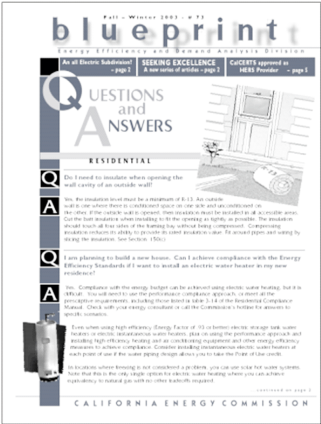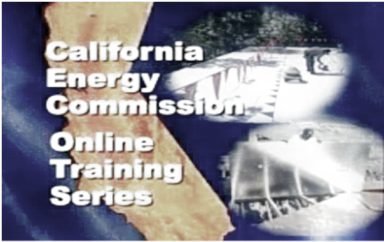
The Energy Commission has a number of resources to help designers, builders, homeowners and others understand and apply the Standards.
A. Telephone Hotline
If the information contained in the Standards or this compliance 'manual are not sufficient to answer a specific question concerning compliance or enforcement, technical assistance is available from the Energy Standards Hotline.
You can reach the Energy Standards Hotline on weekdays from 8 a.m. – noon and 1 p.m. – 4:30 p.m.:
(800) 772-3300
(916) 654-5106
B. Publications
Publications, including the 2013 Building Energy Efficiency Standards, the 2013 Reference Appendices, and the 2013 Residential ACM Approval and Reference Manuals, and others are available from the Energy Commission’s website at www.energy.ca.gov/title24. Paper copies may also be ordered from:
Publications Unit
1516 Ninth Street, MS-13
Sacramento, CA 95814
(916) 654-5200
C. Blueprint
The Energy Commission publishes the Blueprint, a quarterly newsletter that answers questions and addresses issues related to enforcement and compliance. The Blueprint also provides updated information on technical assistance and computer compliance programs and lists of training opportunities offered throughout the state. The Blueprint is available online at www.energy.ca.gov/efficiency/blueprint.

D. Appliance Standards
Appliances, as defined by the Energy Commission, include everything from dishwashers and refrigerators to air conditioners and boilers. The performance of some appliances, such as air conditioners, water heaters, and furnaces, is critical to the building energy efficiency standards. The energy efficiency of other appliances such as refrigerators, dishwashers, and clothes dryers is important to homeowners, but does not affect the building energy efficiency standards, since these are considered home furnishings.
The Energy Commission has comprehensive standards that affect the performance of many appliances. These are published in the 2012 Appliance Efficiency Regulations, CEC-400-2010-012. This document is available from the Energy Commission website at www.energy.ca.gov/appliances/ or can be ordered from the Energy Commission Publications Unit (see contact information above).
E. Appliance Directories
The Energy Commission publishes information on the energy efficiency of appliances. Energy Commission approved directories can be used to determine if appliances meet the mandatory measures and/or the prescriptive requirements. Data may also be used in performance calculations. The Energy Standards Hotline can verify certification of appliances and provide information on appropriate directories.
The complete appliance database (including manufacturer, brand codes, rated efficiencies, etc.) can be searched from the Energy Commission’s website at:
F. Directory of Certified Insulation Materials
Manufacturers whose insulating materials are certified for sale in California are 'listed in the Department of Consumer Affair’s Consumer Guide and Directory of Certified Insulation Material. Each building department receives a copy of this directory. If an insulating product is not 'listed in the directory, or to purchase a directory, contact the Department of Consumer Affairs, Bureau of Electronic Appliance and Repair, Home Furnishings and Thermal Insulation (BEARHFTI), at (916) 999-2041.
If you are interested in attending a training seminar on the Standards, sign up to receive a free subscription to the Blueprint.
Some colleges provide classes on building energy conservation and the Standards. Information about these classes should be obtained directly from the college.
California utilities, organizations of energy consultants, building industry, trade associations, and organizations that serve building officials often sponsor or conduct classes on compliance and enforcement of the Title 24 Building Energy Efficiency Standards. These classes are often 'listed in the Blueprint or posted on the Energy Commission’s website at www.energy.ca.gov/title24.
The California Association of Building Energy Consultants (CABEC) maintains a directory of consultants who provide compliance assistance. The listing is available at www.cabec.org.
The Energy Commission has a series of streaming videos (see Table 1-3 below) that explain energy efficiency concepts and the application of the standards. These videos cover topics including plan checking, field inspection, HVAC, HERS, water heating, building envelope, and renewable energy. They can be viewed at www.energyvideos.com.

More than 100 videos produced by the Energy Commission include discussions, instructions, resources, and requirements for building residential structures.
To achieve compliance with the Standards, some buildings require third-party diagnostic testing or field verification of energy efficient systems or devices. HERS (Home Energy Rating System) raters are required to be hired by the builder or building owner to perform this work. Installing contractors may hire the HERS rater for HVAC changeouts only if the homeowner agrees that the installing contractor may do so on their behalf. The Energy Commission approves HERS providers who train, certify, and monitor HERS raters. For a list of the current HERS providers, please go the Energy Commission website at: http://www.energy.ca.gov/HERS/. To find a rater, go to the website of the approved HERS provider available on the Energy Commission’s website at the link above, or contact the Energy Standards Hotline at (800) 772-3300 (for calls within California) or (916) 654-5106 for assistance.
|
Area |
Topic |
Content |
|
Plan Checking |
The Plan Checking Process The Plan Checking Process - Mandatory Measures Total Energy Inspection - Pt. 1 Total Energy Inspection - Pt. 2 The Inspection Process - Foundations The Inspection Process - Framing |
The Inspection Process - Final Inspection CABEC Certified Energy Analysts Water Heating Overview for Inspectors Kitchen and Bath Lighting Energy Budget vs. Mandatory Measures |
|
HERS Providers and Raters (T-24) |
Blower Door California Home Energy Efficiency Rating System |
Code Enforcement |
|
Space Heating and Cooling |
Overview Duct Design Duct Sealing with Duct Tape Energy Code Requirements HVAC Lineset Insulation TXV - Proper sizing of A/C units and ducts TXV - Proper installation of A/C units and airflow |
TXV - Proper charge for A/C units TXV -Title 24 and AB 970 compliance Title 24 Zonal Control HVAC Zoning for Comfort and Energy Savings Exhaust Ventilation Systems Overview of Exhaust Ventilation Exhaust Ventilation Energy Code Requirements |
|
Water Heating |
Code: Gas Water Heaters Gas Water Heating Overview for Inspectors Overview Installation |
Consumer Energy Rebate Program AB-970 Gas Tankless Water Heaters - Overview Gas Tankless Water Heaters - Installation |
|
|
Energy Code Requirements - Fiberglass Cellulose Insulation - Overview Cellulose Insulation - Insulating Walls Cellulose Insulation - Insulating Ceilings Fiberglass Insulation - Overview and Insulating Ceilings Fiberglass Insulation - Ceiling Insulation Details Fiberglass Insulation - Installing Ductboard Fiberglass Insulation - Insulating Walls Fiberglass Insulation - Wall Insulation Details Spray Foam Insulation Structural Insulated Panels |
Fenestration - Energy Code
Requirements Manufacturing Low-e Glass Energy Performance Area of Glass - Impact on Compliance with Title 24 Window Sizing Window Performance Housewrap - Overview Installing an Air Barrier Air Barrier Details Energy Code Requirements Radiant Barriers - Overview Installing Flexible Radiant Barriers Installing Radiant Barrier Sheathing Radiant Barrier Energy Code Requirements |
|
Renewable Energy |
Overview of Photovoltaic Technology Installing a Photovoltaic System Renewable Energy Rebates |
Renewable Energy: Wind Renewable Energy: Residential Wind Generation |
|
Beyond the Code |
Major West Coast Builder Finds Profitable New Market The Building Science of It Energy Consultants: Building Better, Selling Faster Why it is Profitable as a Marketing Strategy |
Biggest Production Builder Leads the Way HVAC Diagnostics Mold in Buildings Preventing Mold in Buildings |
|
Additions and Alterations |
Perspectives on Residential Additions Title 24: Residential Additions Title 24: Residential Alterations |
____________________________________________ |